-
Notifications
You must be signed in to change notification settings - Fork 63
transforms.scad
This is the file that the most commonly used transformations, distributors, and mutator are in. To use, add the following lines to the beginning of your file:
include <BOSL/constants.scad>
use <BOSL/transforms.scad>
Usage:
- move([x], [y], [z]) ...
- move([x,y,z]) ...
Description: Moves/translates children.
| Argument | What it does |
|---|---|
x |
X axis translation. |
y |
Y axis translation. |
z |
Z axis translation. |
Example 1:
#sphere(d=10);
move([0,20,30]) sphere(d=10);

Example 2:
#sphere(d=10);
move(y=20) sphere(d=10);

Example 3:
#sphere(d=10);
move(x=-10, y=-5) sphere(d=10);

Usage:
- xmove(x) ...
Description: Moves/translates children the given amount along the X axis.
| Argument | What it does |
|---|---|
x |
Amount to move right along the X axis. Negative values move left. |
Example:
#sphere(d=10);
xmove(20) sphere(d=10);
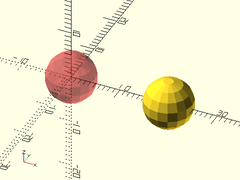
Usage:
- ymove(y) ...
Description: Moves/translates children the given amount along the Y axis.
| Argument | What it does |
|---|---|
y |
Amount to move back along the Y axis. Negative values move forward. |
Example:
#sphere(d=10);
ymove(20) sphere(d=10);

Usage:
- zmove(z) ...
Description: Moves/translates children the given amount along the Z axis.
| Argument | What it does |
|---|---|
z |
Amount to move up along the Z axis. Negative values move down. |
Example:
#sphere(d=10);
zmove(20) sphere(d=10);

Usage:
- left(x) ...
Description: Moves children left (in the X- direction) by the given amount.
| Argument | What it does |
|---|---|
x |
Scalar amount to move left. |
Example:
#sphere(d=10);
left(20) sphere(d=10);

Usage:
- right(x) ...
Description: Moves children right (in the X+ direction) by the given amount.
| Argument | What it does |
|---|---|
x |
Scalar amount to move right. |
Example:
#sphere(d=10);
right(20) sphere(d=10);

Usage:
- fwd(y) ...
- forward(y) ...
Description: Moves children forward (in the Y- direction) by the given amount.
| Argument | What it does |
|---|---|
y |
Scalar amount to move forward. |
Example:
#sphere(d=10);
fwd(20) sphere(d=10);
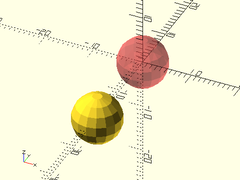
Usage:
- back(y) ...
Description: Moves children back (in the Y+ direction) by the given amount.
| Argument | What it does |
|---|---|
y |
Scalar amount to move back. |
Example:
#sphere(d=10);
back(20) sphere(d=10);

Usage:
- down(z) ...
Description: Moves children down (in the Z- direction) by the given amount.
| Argument | What it does |
|---|---|
z |
Scalar amount to move down. |
Example:
#sphere(d=10);
down(20) sphere(d=10);

Usage:
- up(z) ...
Description: Moves children up (in the Z+ direction) by the given amount.
| Argument | What it does |
|---|---|
z |
Scalar amount to move up. |
Example:
#sphere(d=10);
up(20) sphere(d=10);

Usage:
- rot(a, [cp], [reverse]) ...
- rot([X,Y,Z], [cp], [reverse]) ...
- rot(a, v, [cp], [reverse]) ...
- rot(from, to, [a], [reverse]) ...
Description:
Rotates children around an arbitrary axis by the given number of degrees.
Can be used as a drop-in replacement for rotate(), with extra features.
| Argument | What it does |
|---|---|
a |
Scalar angle or vector of XYZ rotation angles to rotate by, in degrees. |
v |
vector for the axis of rotation. Default: [0,0,1] or V_UP |
cp |
centerpoint to rotate around. Default: [0,0,0] |
from |
Starting vector for vector-based rotations. |
to |
Target vector for vector-based rotations. |
reverse |
If true, exactly reverses the rotation, including axis rotation ordering. Default: false |
Example 1:
#cube([2,4,9]);
rot([30,60,0], cp=[0,0,9]) cube([2,4,9]);

Example 2:
#cube([2,4,9]);
rot(30, v=[1,1,0], cp=[0,0,9]) cube([2,4,9]);

Example 3:
#cube([2,4,9]);
rot(from=V_UP, to=V_LEFT+V_BACK) cube([2,4,9]);

Usage:
- xrot(a, [cp]) ...
Description: Rotates children around the X axis by the given number of degrees.
| Argument | What it does |
|---|---|
a |
angle to rotate by in degrees. |
cp |
centerpoint to rotate around. Default: [0,0,0] |
Example:
#cylinder(h=50, r=10, center=true);
xrot(90) cylinder(h=50, r=10, center=true);

Usage:
- yrot(a, [cp]) ...
Description: Rotates children around the Y axis by the given number of degrees.
| Argument | What it does |
|---|---|
a |
angle to rotate by in degrees. |
cp |
centerpoint to rotate around. Default: [0,0,0] |
Example:
#cylinder(h=50, r=10, center=true);
yrot(90) cylinder(h=50, r=10, center=true);

Usage:
- zrot(a, [cp]) ...
Description: Rotates children around the Z axis by the given number of degrees.
| Argument | What it does |
|---|---|
a |
angle to rotate by in degrees. |
cp |
centerpoint to rotate around. Default: [0,0,0] |
Example:
#cube(size=[60,20,40], center=true);
zrot(90) cube(size=[60,20,40], center=true);

Usage:
- xscale(x) ...
Description: Scales children by the given factor on the X axis.
| Argument | What it does |
|---|---|
x |
Factor to scale by along the X axis. |
Example:
xscale(3) sphere(r=10);

Usage:
- yscale(y) ...
Description: Scales children by the given factor on the Y axis.
| Argument | What it does |
|---|---|
y |
Factor to scale by along the Y axis. |
Example:
yscale(3) sphere(r=10);
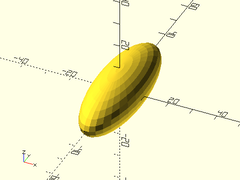
Usage:
- zscale(z) ...
Description: Scales children by the given factor on the Z axis.
| Argument | What it does |
|---|---|
z |
Factor to scale by along the Z axis. |
Example:
zscale(3) sphere(r=10);

Usage:
- xflip([cp]) ...
Description:
Mirrors the children along the X axis, like mirror([1,0,0]) or xscale(-1)
| Argument | What it does |
|---|---|
cp |
A point that lies on the plane of reflection. |
Example 1:
xflip() yrot(90) cylinder(d1=10, d2=0, h=20);
color("blue", 0.25) cube([0.01,15,15], center=true);
color("red", 0.333) yrot(90) cylinder(d1=10, d2=0, h=20);

Example 2:
xflip(cp=[-5,0,0]) yrot(90) cylinder(d1=10, d2=0, h=20);
color("blue", 0.25) left(5) cube([0.01,15,15], center=true);
color("red", 0.333) yrot(90) cylinder(d1=10, d2=0, h=20);

Usage:
- yflip([cp]) ...
Description:
Mirrors the children along the Y axis, like mirror([0,1,0]) or yscale(-1)
| Argument | What it does |
|---|---|
cp |
A point that lies on the plane of reflection. |
Example 1:
yflip() xrot(90) cylinder(d1=10, d2=0, h=20);
color("blue", 0.25) cube([15,0.01,15], center=true);
color("red", 0.333) xrot(90) cylinder(d1=10, d2=0, h=20);

Example 2:
yflip(cp=[0,5,0]) xrot(90) cylinder(d1=10, d2=0, h=20);
color("blue", 0.25) back(5) cube([15,0.01,15], center=true);
color("red", 0.333) xrot(90) cylinder(d1=10, d2=0, h=20);

Usage:
- zflip([cp]) ...
Description:
Mirrors the children along the Z axis, like mirror([0,0,1]) or zscale(-1)
| Argument | What it does |
|---|---|
cp |
A point that lies on the plane of reflection. |
Example 1:
zflip() cylinder(d1=10, d2=0, h=20);
color("blue", 0.25) cube([15,15,0.01], center=true);
color("red", 0.333) cylinder(d1=10, d2=0, h=20);

Example 2:
zflip(cp=[0,0,-5]) cylinder(d1=10, d2=0, h=20);
color("blue", 0.25) down(5) cube([15,15,0.01], center=true);
color("red", 0.333) cylinder(d1=10, d2=0, h=20);

Usage:
- skew_xy([xa], [ya]) ...
- skew_z([xa], [ya]) ...
Description: Skews children on the X-Y plane, keeping constant in Z.
| Argument | What it does |
|---|---|
xa |
skew angle towards the X direction. |
ya |
skew angle towards the Y direction. |
planar |
If true, this becomes a 2D operation. |
Example 1:
#cube(size=10);
skew_xy(xa=30, ya=15) cube(size=10);
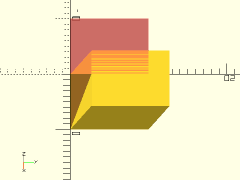
Example 2:
skew_xy(xa=15,ya=30,planar=true) square(30);

Usage:
- skew_yz([ya], [za]) ...
- skew_x([ya], [za]) ...
Description: Skews children on the Y-Z plane, keeping constant in X.
| Argument | What it does |
|---|---|
ya |
skew angle towards the Y direction. |
za |
skew angle towards the Z direction. |
Example:
#cube(size=10);
skew_yz(ya=30, za=15) cube(size=10);

Usage:
- skew_xz([xa], [za]) ...
- skew_y([xa], [za]) ...
Description: Skews children on the X-Z plane, keeping constant in Y.
| Argument | What it does |
|---|---|
xa |
skew angle towards the X direction. |
za |
skew angle towards the Z direction. |
Example:
#cube(size=10);
skew_xz(xa=15, za=-10) cube(size=10);

Usage:
- place_copies(a) ...
Description: Makes copies of the given children at each of the given offsets.
| Argument | What it does |
|---|---|
a |
array of XYZ offset vectors. Default 0,0,0 |
Side Effects:
-
$posis set to the relative centerpoint of each child copy, and can be used to modify each child individually.
Example:
#sphere(r=10);
place_copies([[-25,-25,0], [25,-25,0], [0,0,50], [0,25,0]]) sphere(r=10);

Usage:
- spread(l, [n], [p1]) ...
- spread(l, spacing, [p1]) ...
- spread(spacing, [n], [p1]) ...
- spread(p1, p2, [n]) ...
- spread(p1, p2, spacing) ...
Description:
Evenly distributes n copies of all children along a line.
Copies every child at each position.
| Argument | What it does |
|---|---|
p1 |
Starting point of line. |
p2 |
Ending point of line. |
l |
Length to spread copies over. |
spacing |
A 3D vector indicating which direction and distance to place each subsequent copy at. |
n |
Number of copies to distribute along the line. (Default: 2) |
Side Effects:
-
$posis set to the relative centerpoint of each child copy, and can be used to modify each child individually. -
$idxis set to the index number of each child being copied.
Example 1:
spread([0,0,0], [5,5,20], n=6) cube(size=[3,2,1],center=true);

Example 2:
spread(l=40, n=6) cube(size=[3,2,1],center=true);

Example 3:
spread(l=[15,30], n=6) cube(size=[3,2,1],center=true);
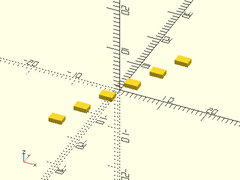
Example 4:
spread(l=40, spacing=10) cube(size=[3,2,1],center=true);

Example 5:
spread(spacing=[5,5,0], n=5) cube(size=[3,2,1],center=true);

Example 6:
spread(l=20, n=3) {
cube(size=[1,3,1],center=true);
cube(size=[3,1,1],center=true);
}

Usage:
- xspread(spacing, [n], [sp]) ...
- xspread(l, [n], [sp]) ...
Description:
Spreads out n copies of the children along a line on the X axis.
| Argument | What it does |
|---|---|
spacing |
spacing between copies. (Default: 1.0) |
n |
Number of copies to spread out. (Default: 2) |
l |
Length to spread copies over. |
sp |
If given, copies will be spread on a line to the right of starting position sp. If not given, copies will be spread along a line that is centered at [0,0,0]. |
Side Effects:
-
$posis set to the relative centerpoint of each child copy, and can be used to modify each child individually. -
$idxis set to the index number of each child being copied.
Example 1:
xspread(20) sphere(3);

Example 2:
xspread(20, n=3) sphere(3);

Example 3:
xspread(spacing=15, l=50) sphere(3);

Example 4:
xspread(n=4, l=30, sp=[0,10,0]) sphere(3);
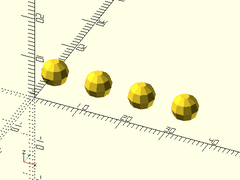
Example 5:
xspread(10, n=3) {
cube(size=[1,3,1],center=true);
cube(size=[3,1,1],center=true);
}

Usage:
- yspread(spacing, [n], [sp]) ...
- yspread(l, [n], [sp]) ...
Description:
Spreads out n copies of the children along a line on the Y axis.
| Argument | What it does |
|---|---|
spacing |
spacing between copies. (Default: 1.0) |
n |
Number of copies to spread out. (Default: 2) |
l |
Length to spread copies over. |
sp |
If given, copies will be spread on a line back from starting position sp. If not given, copies will be spread along a line that is centered at [0,0,0]. |
Side Effects:
-
$posis set to the relative centerpoint of each child copy, and can be used to modify each child individually. -
$idxis set to the index number of each child being copied.
Example 1:
yspread(20) sphere(3);

Example 2:
yspread(20, n=3) sphere(3);

Example 3:
yspread(spacing=15, l=50) sphere(3);

Example 4:
yspread(n=4, l=30, sp=[10,0,0]) sphere(3);

Example 5:
yspread(10, n=3) {
cube(size=[1,3,1],center=true);
cube(size=[3,1,1],center=true);
}

Usage:
- zspread(spacing, [n], [sp]) ...
- zspread(l, [n], [sp]) ...
Description:
Spreads out n copies of the children along a line on the Z axis.
| Argument | What it does |
|---|---|
spacing |
spacing between copies. (Default: 1.0) |
n |
Number of copies to spread out. (Default: 2) |
l |
Length to spread copies over. |
sp |
If given, copies will be spread on a line up from starting position sp. If not given, copies will be spread along a line that is centered at [0,0,0]. |
Side Effects:
-
$posis set to the relative centerpoint of each child copy, and can be used to modify each child individually. -
$idxis set to the index number of each child being copied.
Example 1:
zspread(20) sphere(3);

Example 2:
zspread(20, n=3) sphere(3);

Example 3:
zspread(spacing=15, l=50) sphere(3);

Example 4:
zspread(n=4, l=30, sp=[10,0,0]) sphere(3);

Example 5:
zspread(10, n=3) {
cube(size=[1,3,1],center=true);
cube(size=[3,1,1],center=true);
}

Usage:
- distribute(spacing, dir, [sizes]) ...
- distribute(l, dir, [sizes]) ...
Description:
Spreads out each individual child along the direction dir.
Every child is placed at a different position, in order.
This is useful for laying out groups of disparate objects
where you only really care about the spacing between them.
| Argument | What it does |
|---|---|
spacing |
Spacing to add between each child. (Default: 10.0) |
sizes |
Array containing how much space each child will need. |
dir |
Vector direction to distribute copies along. |
l |
Length to distribute copies along. |
Example:
distribute(sizes=[100, 30, 50], dir=V_UP) {
sphere(r=50);
cube([10,20,30], center=true);
cylinder(d=30, h=50, center=true);
}

Usage:
- xdistribute(spacing, [sizes]) ...
- xdistribute(l, [sizes]) ...
Description: Spreads out each individual child along the X axis. Every child is placed at a different position, in order. This is useful for laying out groups of disparate objects where you only really care about the spacing between them.
| Argument | What it does |
|---|---|
spacing |
spacing between each child. (Default: 10.0) |
sizes |
Array containing how much space each child will need. |
l |
Length to distribute copies along. |
Example:
xdistribute(sizes=[100, 10, 30], spacing=40) {
sphere(r=50);
cube([10,20,30], center=true);
cylinder(d=30, h=50, center=true);
}
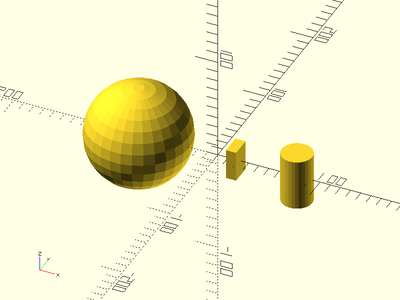
Usage:
- ydistribute(spacing, [sizes])
- ydistribute(l, [sizes])
Description: Spreads out each individual child along the Y axis. Every child is placed at a different position, in order. This is useful for laying out groups of disparate objects where you only really care about the spacing between them.
| Argument | What it does |
|---|---|
spacing |
spacing between each child. (Default: 10.0) |
sizes |
Array containing how much space each child will need. |
l |
Length to distribute copies along. |
Example:
ydistribute(sizes=[30, 20, 100], spacing=40) {
cylinder(d=30, h=50, center=true);
cube([10,20,30], center=true);
sphere(r=50);
}

Usage:
- zdistribute(spacing, [sizes])
- zdistribute(l, [sizes])
Description: Spreads out each individual child along the Z axis. Every child is placed at a different position, in order. This is useful for laying out groups of disparate objects where you only really care about the spacing between them.
| Argument | What it does |
|---|---|
spacing |
spacing between each child. (Default: 10.0) |
sizes |
Array containing how much space each child will need. |
l |
Length to distribute copies along. |
Example:
zdistribute(sizes=[30, 20, 100], spacing=40) {
cylinder(d=30, h=50, center=true);
cube([10,20,30], center=true);
sphere(r=50);
}

Usage:
- grid2d(size, spacing, [stagger], [scale], [in_poly], [orient], [align]) ...
- grid2d(size, cols, rows, [stagger], [scale], [in_poly], [orient], [align]) ...
- grid2d(spacing, cols, rows, [stagger], [scale], [in_poly], [orient], [align]) ...
- grid2d(spacing, in_poly, [stagger], [scale], [orient], [align]) ...
- grid2d(cols, rows, in_poly, [stagger], [scale], [orient], [align]) ...
Description: Makes a square or hexagonal grid of copies of children.
| Argument | What it does |
|---|---|
size |
The [X,Y] size to spread the copies over. |
spacing |
Distance between copies in [X,Y] or scalar distance. |
cols |
How many columns of copies to make. If staggered, count both staggered and unstaggered columns. |
rows |
How many rows of copies to make. If staggered, count both staggered and unstaggered rows. |
stagger |
If true, make a staggered (hexagonal) grid. If false, make square grid. If "alt", makes alternate staggered pattern. Default: false |
scale |
[X,Y] scaling factors to reshape grid. |
in_poly |
If given a list of polygon points, only creates copies whose center would be inside the polygon. Polygon can be concave and/or self crossing. |
orient |
Orientation axis for the grid. Orientation is NOT applied to individual children. |
align |
Alignment of the grid. Alignment is NOT applies to individual children. |
Side Effects:
-
$posis set to the relative centerpoint of each child copy, and can be used to modify each child individually. -
$colis set to the integer column number for each child. -
$rowis set to the integer row number for each child.
Example 1:
grid2d(size=50, spacing=10, stagger=false) cylinder(d=10, h=1);

Example 2:
grid2d(spacing=10, rows=7, cols=13, stagger=true) cylinder(d=6, h=5);

Example 3:
grid2d(spacing=10, rows=7, cols=13, stagger="alt") cylinder(d=6, h=5);
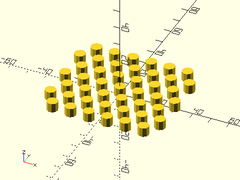
Example 4:
grid2d(size=50, rows=11, cols=11, stagger=true) cylinder(d=5, h=1);

Example 5:
poly = [[-25,-25], [25,25], [-25,25], [25,-25]];
grid2d(spacing=5, stagger=true, in_poly=poly)
zrot(180/6) cylinder(d=5, h=1, $fn=6);
%polygon(poly);
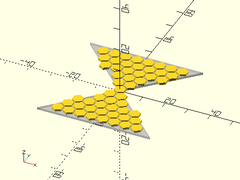
Example 6:
// Makes a grid of hexagon pillars whose tops are all angled
// to reflect light at [0,0,50], if they were reflective.
use <BOSL/math.scad>
hexregion = [for (a = [0:60:359.9]) 50.01*[cos(a), sin(a)]];
grid2d(spacing=10, stagger=true, in_poly=hexregion) {
// Note: You must use for(var=[val]) or let(var=val)
// to set vars from $pos or other special vars in this scope.
let (ref_v = (normalize([0,0,50]-point3d($pos)) + V_UP)/2)
half_of(v=-ref_v, cp=[0,0,5])
zrot(180/6)
cylinder(h=20, d=10/cos(180/6)+0.01, $fn=6);
}

Usage:
- grid3d(n, spacing) ...
- grid3d(n=[Xn,Yn,Zn], spacing=[dX,dY,dZ]) ...
- grid3d([xa], [ya], [za]) ...
Description: Makes a 3D grid of duplicate children.
| Argument | What it does |
|---|---|
xa |
array or range of X-axis values to offset by. (Default: [0]) |
ya |
array or range of Y-axis values to offset by. (Default: [0]) |
za |
array or range of Z-axis values to offset by. (Default: [0]) |
n |
Optional number of copies to have per axis. |
spacing |
spacing of copies per axis. Use with n. |
Example 1:
grid3d(xa=[0:25:50],ya=[0,40],za=[-20:40:20]) sphere(r=5);

Example 2:
grid3d(n=[3, 4, 2], spacing=[60, 50, 40]) sphere(r=10);

Example 3:
grid3d(ya=[-60:40:60],za=[0,70]) sphere(r=10);
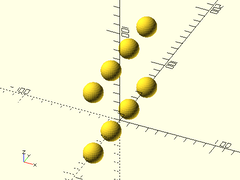
Example 4:
grid3d(n=3, spacing=30) sphere(r=10);

Example 5:
grid3d(n=[3, 1, 2], spacing=30) sphere(r=10);

Example 6:
grid3d(n=[3, 4], spacing=[80, 60]) sphere(r=10);

Example 7:
grid3d(n=[10, 10, 10], spacing=50) color($idx/9) cube(50, center=true);

Usage:
- rot_copies(rots, [cp], [sa], [delta], [subrot]) ...
- rot_copies(rots, v, [cp], [sa], [delta], [subrot]) ...
- rot_copies(n, [v], [cp], [sa], [delta], [subrot]) ...
Description:
Given a number of XYZ rotation angles, or a list of angles and an axis v,
rotates copies of the children to each of those angles.
| Argument | What it does |
|---|---|
rots |
A list of [X,Y,Z] rotation angles in degrees. If v is given, this will be a list of scalar angles in degrees to rotate around v. |
v |
If given, this is the vector to rotate around. |
cp |
Centerpoint to rotate around. |
n |
Optional number of evenly distributed copies, rotated around the ring. If given, overrides rots argument. |
sa |
Starting angle, in degrees. For use with n. Angle is in degrees counter-clockwise. |
delta |
[X,Y,Z] amount to move away from cp before rotating. Makes rings of copies. |
subrot |
If false, don't sub-rotate children as they are copied around the ring. |
Side Effects:
-
$angis set to the rotation angle (or XYZ rotation triplet) of each child copy, and can be used to modify each child individually. -
$idxis set to the index value of each child copy.
Example 1:
#cylinder(h=20, r1=5, r2=0);
rot_copies([[45,0,0],[0,45,90],[90,-45,270]]) cylinder(h=20, r1=5, r2=0);

Example 2:
rot_copies([45, 90, 135], v=V_DOWN+V_BACK)
yrot(90) cylinder(h=20, r1=5, r2=0);
color("red",0.333) yrot(90) cylinder(h=20, r1=5, r2=0);

Example 3:
rot_copies(n=6, v=V_DOWN+V_BACK)
yrot(90) cylinder(h=20, r1=5, r2=0);
color("red",0.333) yrot(90) cylinder(h=20, r1=5, r2=0);

Example 4:
rot_copies(n=6, v=V_DOWN+V_BACK, delta=[10,0,0])
yrot(90) cylinder(h=20, r1=5, r2=0);
color("red",0.333) yrot(90) cylinder(h=20, r1=5, r2=0);

Example 5:
rot_copies(n=6, v=V_UP+V_FWD, delta=[10,0,0], sa=45)
yrot(90) cylinder(h=20, r1=5, r2=0);
color("red",0.333) yrot(90) cylinder(h=20, r1=5, r2=0);

Example 6:
rot_copies(n=6, v=V_DOWN+V_BACK, delta=[20,0,0], subrot=false)
yrot(90) cylinder(h=20, r1=5, r2=0);
color("red",0.333) yrot(90) cylinder(h=20, r1=5, r2=0);
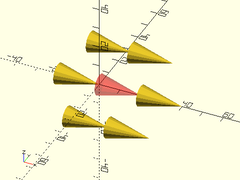
Usage:
- xrot_copies(rots, [r], [cp], [sa], [subrot]) ...
- xrot_copies(n, [r], [cp], [sa], [subrot]) ...
Description: Given an array of angles, rotates copies of the children to each of those angles around the X axis.
| Argument | What it does |
|---|---|
rots |
Optional array of rotation angles, in degrees, to make copies at. |
cp |
Centerpoint to rotate around. |
n |
Optional number of evenly distributed copies to be rotated around the ring. If given, overrides rots argument. |
sa |
Starting angle, in degrees. For use with n. Angle is in degrees counter-clockwise from Y+, when facing the origin from X+. First unrotated copy is placed at that angle. |
r |
Radius to move children back, away from cp, before rotating. Makes rings of copies. |
subrot |
If false, don't sub-rotate children as they are copied around the ring. |
Side Effects:
-
$angis set to the rotation angle of each child copy, and can be used to modify each child individually.
Example 1:
xrot_copies([180, 270, 315])
cylinder(h=20, r1=5, r2=0);
color("red",0.333) cylinder(h=20, r1=5, r2=0);

Example 2:
xrot_copies(n=6)
cylinder(h=20, r1=5, r2=0);
color("red",0.333) cylinder(h=20, r1=5, r2=0);
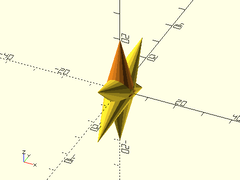
Example 3:
xrot_copies(n=6, r=10)
xrot(-90) cylinder(h=20, r1=5, r2=0);
color("red",0.333) xrot(-90) cylinder(h=20, r1=5, r2=0);

Example 4:
xrot_copies(n=6, r=10, sa=45)
xrot(-90) cylinder(h=20, r1=5, r2=0);
color("red",0.333) xrot(-90) cylinder(h=20, r1=5, r2=0);

Example 5:
xrot_copies(n=6, r=20, subrot=false)
xrot(-90) cylinder(h=20, r1=5, r2=0, center=true);
color("red",0.333) xrot(-90) cylinder(h=20, r1=5, r2=0, center=true);

Usage:
- yrot_copies(rots, [r], [cp], [sa], [subrot]) ...
- yrot_copies(n, [r], [cp], [sa], [subrot]) ...
Description: Given an array of angles, rotates copies of the children to each of those angles around the Y axis.
| Argument | What it does |
|---|---|
rots |
Optional array of rotation angles, in degrees, to make copies at. |
cp |
Centerpoint to rotate around. |
n |
Optional number of evenly distributed copies to be rotated around the ring. If given, overrides rots argument. |
sa |
Starting angle, in degrees. For use with n. Angle is in degrees counter-clockwise from X-, when facing the origin from Y+. |
r |
Radius to move children left, away from cp, before rotating. Makes rings of copies. |
subrot |
If false, don't sub-rotate children as they are copied around the ring. |
Side Effects:
-
$angis set to the rotation angle of each child copy, and can be used to modify each child individually.
Example 1:
yrot_copies([180, 270, 315])
cylinder(h=20, r1=5, r2=0);
color("red",0.333) cylinder(h=20, r1=5, r2=0);
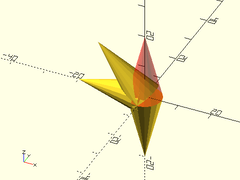
Example 2:
yrot_copies(n=6)
cylinder(h=20, r1=5, r2=0);
color("red",0.333) cylinder(h=20, r1=5, r2=0);

Example 3:
yrot_copies(n=6, r=10)
yrot(-90) cylinder(h=20, r1=5, r2=0);
color("red",0.333) yrot(-90) cylinder(h=20, r1=5, r2=0);

Example 4:
yrot_copies(n=6, r=10, sa=45)
yrot(-90) cylinder(h=20, r1=5, r2=0);
color("red",0.333) yrot(-90) cylinder(h=20, r1=5, r2=0);

Example 5:
yrot_copies(n=6, r=20, subrot=false)
yrot(-90) cylinder(h=20, r1=5, r2=0, center=true);
color("red",0.333) yrot(-90) cylinder(h=20, r1=5, r2=0, center=true);

Usage:
- zrot_copies(rots, [r], [cp], [sa], [subrot]) ...
- zrot_copies(n, [r], [cp], [sa], [subrot]) ...
Description: Given an array of angles, rotates copies of the children to each of those angles around the Z axis.
| Argument | What it does |
|---|---|
rots |
Optional array of rotation angles, in degrees, to make copies at. |
cp |
Centerpoint to rotate around. |
n |
Optional number of evenly distributed copies to be rotated around the ring. If given, overrides rots argument. |
sa |
Starting angle, in degrees. For use with n. Angle is in degrees counter-clockwise from X+, when facing the origin from Z+. |
r |
Radius to move children right, away from cp, before rotating. Makes rings of copies. |
subrot |
If false, don't sub-rotate children as they are copied around the ring. |
Side Effects:
-
$angis set to the rotation angle of each child copy, and can be used to modify each child individually.
Example 1:
zrot_copies([180, 270, 315])
yrot(90) cylinder(h=20, r1=5, r2=0);
color("red",0.333) yrot(90) cylinder(h=20, r1=5, r2=0);

Example 2:
zrot_copies(n=6)
yrot(90) cylinder(h=20, r1=5, r2=0);
color("red",0.333) yrot(90) cylinder(h=20, r1=5, r2=0);

Example 3:
zrot_copies(n=6, r=10)
yrot(90) cylinder(h=20, r1=5, r2=0);
color("red",0.333) yrot(90) cylinder(h=20, r1=5, r2=0);

Example 4:
zrot_copies(n=6, r=20, sa=45)
yrot(90) cylinder(h=20, r1=5, r2=0, center=true);
color("red",0.333) yrot(90) cylinder(h=20, r1=5, r2=0, center=true);

Example 5:
zrot_copies(n=6, r=20, subrot=false)
yrot(-90) cylinder(h=20, r1=5, r2=0, center=true);
color("red",0.333) yrot(-90) cylinder(h=20, r1=5, r2=0, center=true);

Usage:
- xring(n, r, [sa], [cp], [rot]) ...
Description:
Distributes n copies of the given children on a circle of radius r
around the X axis. If rot is true, each copy is rotated in place to keep
the same side towards the center. The first, unrotated copy will be at the
starting angle sa.
| Argument | What it does |
|---|---|
n |
Number of copies of children to distribute around the circle. (Default: 2) |
r |
Radius of ring to distribute children around. (Default: 0) |
sa |
Start angle for first (unrotated) copy. (Default: 0) |
cp |
Centerpoint of ring. Default: [0,0,0] |
rot |
If true, rotate each copy to keep the same side towards the center of the ring. Default: true. |
Side Effects:
-
$angis set to the rotation angle of each child copy, and can be used to modify each child individually. -
$idxis set to the index value of each child copy.
Example 1:
xring(n=6, r=10) xrot(-90) cylinder(h=20, r1=5, r2=0);

Example 2:
xring(n=6, r=10, sa=45) xrot(-90) cylinder(h=20, r1=5, r2=0);

Example 3:
xring(n=6, r=20, rot=false) cylinder(h=20, r1=6, r2=0, center=true);

Usage:
- yring(n, r, [sa], [cp], [rot]) ...
Description:
Distributes n copies of the given children on a circle of radius r
around the Y axis. If rot is true, each copy is rotated in place to keep
the same side towards the center. The first, unrotated copy will be at the
starting angle sa.
| Argument | What it does |
|---|---|
n |
Number of copies of children to distribute around the circle. (Default: 2) |
r |
Radius of ring to distribute children around. (Default: 0) |
sa |
Start angle for first (unrotated) copy. (Default: 0) |
cp |
Centerpoint of ring. Default: [0,0,0] |
rot |
If true, rotate each copy to keep the same side towards the center of the ring. Default: true. |
Side Effects:
-
$angis set to the rotation angle of each child copy, and can be used to modify each child individually. -
$idxis set to the index value of each child copy.
Example 1:
yring(n=6, r=10) yrot(-90) cylinder(h=20, r1=5, r2=0);

Example 2:
yring(n=6, r=10, sa=45) yrot(-90) cylinder(h=20, r1=5, r2=0);

Example 3:
yring(n=6, r=20, rot=false) cylinder(h=20, r1=6, r2=0, center=true);

Usage:
- zring(r, n, [sa], [cp], [rot]) ...
Description:
Distributes n copies of the given children on a circle of radius r
around the Z axis. If rot is true, each copy is rotated in place to keep
the same side towards the center. The first, unrotated copy will be at the
starting angle sa.
| Argument | What it does |
|---|---|
n |
Number of copies of children to distribute around the circle. (Default: 2) |
r |
Radius of ring to distribute children around. (Default: 0) |
sa |
Start angle for first (unrotated) copy. (Default: 0) |
cp |
Centerpoint of ring. Default: [0,0,0] |
rot |
If true, rotate each copy to keep the same side towards the center of the ring. Default: true. |
Side Effects:
-
$angis set to the relative angle fromcpof each child copy, and can be used to modify each child individually. -
$idxis set to the index value of each child copy.
Example 1:
zring(n=6, r=10) yrot(90) cylinder(h=20, r1=5, r2=0);

Example 2:
zring(n=6, r=10, sa=45) yrot(90) cylinder(h=20, r1=5, r2=0);

Example 3:
zring(n=6, r=20, rot=false) yrot(90) cylinder(h=20, r1=6, r2=0, center=true);

Usage:
- arc_of(r|d, n, [sa], [ea], [rot]
- arc_of(rx|dx, ry|dy, n, [sa], [ea], [rot]
Description: Evenly distributes n duplicate children around an ovoid arc on the XY plane.
| Argument | What it does |
|---|---|
n |
number of copies to distribute around the circle. (Default: 6) |
r |
radius of circle (Default: 1) |
rx |
radius of ellipse on X axis. Used instead of r. |
ry |
radius of ellipse on Y axis. Used instead of r. |
d |
diameter of circle. (Default: 2) |
dx |
diameter of ellipse on X axis. Used instead of d. |
dy |
diameter of ellipse on Y axis. Used instead of d. |
rot |
whether to rotate the copied children. (Default: false) |
sa |
starting angle. (Default: 0.0) |
ea |
ending angle. Will distribute copies CCW from sa to ea. (Default: 360.0) |
Side Effects:
-
$angis set to the rotation angle of each child copy, and can be used to modify each child individually. -
$posis set to the relative centerpoint of each child copy, and can be used to modify each child individually. -
$idxis set to the index value of each child copy.
Example 1:
#cube(size=[10,3,3],center=true);
arc_of(d=40, n=5) cube(size=[10,3,3],center=true);

Example 2:
#cube(size=[10,3,3],center=true);
arc_of(d=40, n=5, sa=45, ea=225) cube(size=[10,3,3],center=true);

Example 3:
#cube(size=[10,3,3],center=true);
arc_of(r=15, n=8, rot=false) cube(size=[10,3,3],center=true);

Example 4:
#cube(size=[10,3,3],center=true);
arc_of(rx=20, ry=10, n=8) cube(size=[10,3,3],center=true);
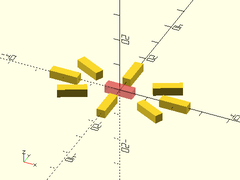
Usage:
- ovoid_spread(r|d, n, [cone_ang], [scale], [perp]) ...
Description: Spreads children semi-evenly over the surface of a sphere.
| Argument | What it does |
|---|---|
r |
Radius of the sphere to distribute over |
d |
Diameter of the sphere to distribute over |
n |
How many copies to evenly spread over the surface. |
cone_ang |
Angle of the cone, in degrees, to limit how much of the sphere gets covered. For full sphere coverage, use 180. Measured pre-scaling. Default: 180 |
scale |
The [X,Y,Z] scaling factors to reshape the sphere being covered. |
perp |
If true, rotate children to be perpendicular to the sphere surface. Default: true |
Side Effects:
-
$posis set to the relative post-scaled centerpoint of each child copy, and can be used to modify each child individually. -
$thetais set to the theta angle of the child from the center of the sphere. -
$phiis set to the pre-scaled phi angle of the child from the center of the sphere. -
$radis set to the pre-scaled radial distance of the child from the center of the sphere. -
$idxis set to the index number of each child being copied.
Example 1:
ovoid_spread(n=250, d=100, cone_ang=45, scale=[3,3,1])
cylinder(d=10, h=10, center=false);

Example 2:
ovoid_spread(n=500, d=100, cone_ang=180)
color(normalize(point3d(vabs($pos))))
cylinder(d=8, h=10, center=false);

Usage:
- mirror_copy(v, [cp], [offset]) ...
Description: Makes a copy of the children, mirrored across the given plane.
| Argument | What it does |
|---|---|
v |
The normal vector of the plane to mirror across. |
offset |
distance to offset away from the plane. |
cp |
A point that lies on the mirroring plane. |
Side Effects:
-
$origis true for the original instance of children. False for the copy. -
$idxis set to the index value of each copy.
Example 1:
mirror_copy([1,-1,0]) zrot(-45) yrot(90) cylinder(d1=10, d2=0, h=20);
color("blue",0.25) zrot(-45) cube([0.01,15,15], center=true);

Example 2:
mirror_copy([1,1,0], offset=5) rot(a=90,v=[-1,1,0]) cylinder(d1=10, d2=0, h=20);
color("blue",0.25) zrot(45) cube([0.01,15,15], center=true);
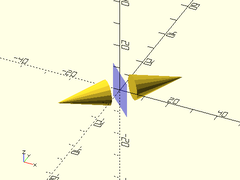
Example 3:
mirror_copy(V_UP+V_BACK, cp=[0,-5,-5]) rot(from=V_UP, to=V_BACK+V_UP) cylinder(d1=10, d2=0, h=20);
color("blue",0.25) translate([0,-5,-5]) rot(from=V_UP, to=V_BACK+V_UP) cube([15,15,0.01], center=true);

Usage:
- xflip_copy([cp], [offset]) ...
Description: Makes a copy of the children, mirrored across the X axis.
| Argument | What it does |
|---|---|
offset |
Distance to offset children right, before copying. |
cp |
A point that lies on the mirroring plane. |
Side Effects:
-
$origis true for the original instance of children. False for the copy. -
$idxis set to the index value of each copy.
Example 1:
xflip_copy() yrot(90) cylinder(h=20, r1=4, r2=0);
color("blue",0.25) cube([0.01,15,15], center=true);
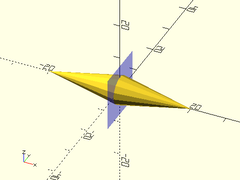
Example 2:
xflip_copy(offset=5) yrot(90) cylinder(h=20, r1=4, r2=0);
color("blue",0.25) cube([0.01,15,15], center=true);

Example 3:
xflip_copy(cp=[-5,0,0]) yrot(90) cylinder(h=20, r1=4, r2=0);
color("blue",0.25) left(5) cube([0.01,15,15], center=true);

Usage:
- yflip_copy([cp], [offset]) ...
Description: Makes a copy of the children, mirrored across the Y axis.
| Argument | What it does |
|---|---|
offset |
Distance to offset children back, before copying. |
cp |
A point that lies on the mirroring plane. |
Side Effects:
-
$origis true for the original instance of children. False for the copy. -
$idxis set to the index value of each copy.
Example 1:
yflip_copy() xrot(-90) cylinder(h=20, r1=4, r2=0);
color("blue",0.25) cube([15,0.01,15], center=true);

Example 2:
yflip_copy(offset=5) xrot(-90) cylinder(h=20, r1=4, r2=0);
color("blue",0.25) cube([15,0.01,15], center=true);

Example 3:
yflip_copy(cp=[0,-5,0]) xrot(-90) cylinder(h=20, r1=4, r2=0);
color("blue",0.25) fwd(5) cube([15,0.01,15], center=true);

Usage:
- zflip_copy([cp], [offset]) ...
-
$idxis set to the index value of each copy.
Description: Makes a copy of the children, mirrored across the Z axis.
| Argument | What it does |
|---|---|
offset |
Distance to offset children up, before copying. |
cp |
A point that lies on the mirroring plane. |
Side Effects:
-
$origis true for the original instance of children. False for the copy.
Example 1:
zflip_copy() cylinder(h=20, r1=4, r2=0);
color("blue",0.25) cube([15,15,0.01], center=true);

Example 2:
zflip_copy(offset=5) cylinder(h=20, r1=4, r2=0);
color("blue",0.25) cube([15,15,0.01], center=true);

Example 3:
zflip_copy(cp=[0,0,-5]) cylinder(h=20, r1=4, r2=0);
color("blue",0.25) down(5) cube([15,15,0.01], center=true);

Usage:
- half_of(v, [cp], [s]) ...
Description: Slices an object at a cut plane, and masks away everything that is on one side.
| Argument | What it does |
|---|---|
v |
Normal of plane to slice at. Keeps everything on the side the normal points to. Default: [0,0,1] (V_UP) |
cp |
If given as a scalar, moves the cut plane along the normal by the given amount. If given as a point, specifies a point on the cut plane. This can be used to shift where it slices the object at. Default: [0,0,0] |
s |
Mask size to use. Use a number larger than twice your object's largest axis. If you make this too large, it messes with centering your view. Default: 100 |
planar |
If true, this becomes a 2D operation. When planar, a v of V_UP or V_DOWN becomes equivalent of V_BACK and V_FWD respectively. |
Example 1:
half_of(V_DOWN+V_BACK, cp=[0,-10,0]) cylinder(h=40, r1=10, r2=0, center=false);
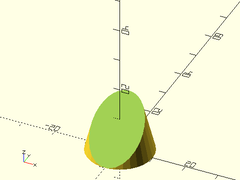
Example 2:
half_of(V_DOWN+V_LEFT, s=200) sphere(d=150);

Example 3:
half_of([1,1], planar=true) circle(d=50);

Usage:
- top_half([z|cp], [s]) ...
Description: Slices an object at a horizontal X-Y cut plane, and masks away everything that is below it.
| Argument | What it does |
|---|---|
cp |
If given as a scalar, moves the cut plane up by the given amount. If given as a point, specifies a point on the cut plane. Default: [0,0,0] |
z |
The Z coordinate of the cut-plane, if given. Use instead of cp. |
s |
Mask size to use. Use a number larger than twice your object's largest axis. If you make this too large, it messes with centering your view. Default: 100 |
planar |
If true, this becomes equivalent to a planar back_half(). |
Example 1:
top_half() sphere(r=20);

Example 2:
top_half(z=5) sphere(r=20);

Example 3:
top_half(cp=5) sphere(r=20);

Example 4:
top_half(cp=[0,0,-8]) sphere(r=20);

Example 5:
top_half(planar=true) circle(r=20);

Usage:
- bottom_half([z|cp], [s]) ...
Description: Slices an object at a horizontal X-Y cut plane, and masks away everything that is above it.
| Argument | What it does |
|---|---|
cp |
If given as a scalar, moves the cut plane down by the given amount. If given as a point, specifies a point on the cut plane. Default: [0,0,0] |
z |
The Z coordinate of the cut-plane, if given. Use instead of cp. |
s |
Mask size to use. Use a number larger than twice your object's largest axis. If you make this too large, it messes with centering your view. Default: 100 |
planar |
If true, this becomes equivalent to a planar front_half(). |
Example 1:
bottom_half() sphere(r=20);
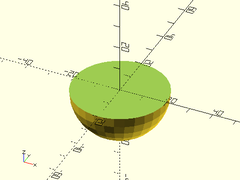
Example 2:
bottom_half(z=-10) sphere(r=20);

Example 3:
bottom_half(cp=-10) sphere(r=20);

Example 4:
bottom_half(cp=[0,0,10]) sphere(r=20);

Example 5:
bottom_half(planar=true) circle(r=20);

Usage:
- left_half([x|cp], [s]) ...
Description: Slices an object at a vertical Y-Z cut plane, and masks away everything that is right of it.
| Argument | What it does |
|---|---|
cp |
If given as a scalar, moves the cut plane left by the given amount. If given as a point, specifies a point on the cut plane. Default: [0,0,0] |
x |
The X coordinate of the cut-plane, if given. Use instead of cp. |
s |
Mask size to use. Use a number larger than twice your object's largest axis. If you make this too large, it messes with centering your view. Default: 100 |
planar |
If true, this becomes a 2D operation. |
Example 1:
left_half() sphere(r=20);

Example 2:
left_half(x=-8) sphere(r=20);

Example 3:
left_half(cp=-8) sphere(r=20);

Example 4:
left_half(cp=[8,0,0]) sphere(r=20);

Example 5:
left_half(planar=true) circle(r=20);

Usage:
- right_half([x|cp], [s]) ...
Description: Slices an object at a vertical Y-Z cut plane, and masks away everything that is left of it.
| Argument | What it does |
|---|---|
cp |
If given as a scalar, moves the cut plane right by the given amount. If given as a point, specifies a point on the cut plane. Default: [0,0,0] |
x |
The X coordinate of the cut-plane, if given. Use instead of cp. |
s |
Mask size to use. Use a number larger than twice your object's largest axis. If you make this too large, it messes with centering your view. Default: 100 |
planar |
If true, this becomes a 2D operation. |
Example 1:
right_half() sphere(r=20);

Example 2:
right_half(x=-5) sphere(r=20);

Example 3:
right_half(cp=-5) sphere(r=20);
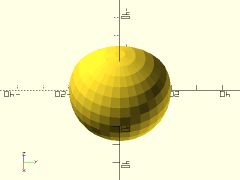
Example 4:
right_half(cp=[-5,0,0]) sphere(r=20);

Example 5:
right_half(planar=true) circle(r=20);

Usage:
- front_half([y|cp], [s]) ...
Description: Slices an object at a vertical X-Z cut plane, and masks away everything that is behind it.
| Argument | What it does |
|---|---|
cp |
If given as a scalar, moves the cut plane forward by the given amount. If given as a point, specifies a point on the cut plane. Default: [0,0,0] |
y |
The Y coordinate of the cut-plane, if given. Use instead of cp. |
s |
Mask size to use. Use a number larger than twice your object's largest axis. If you make this too large, it messes with centering your view. Default: 100 |
planar |
If true, this becomes a 2D operation. |
Example 1:
front_half() sphere(r=20);

Example 2:
front_half(y=5) sphere(r=20);

Example 3:
front_half(cp=5) sphere(r=20);

Example 4:
front_half(cp=[0,5,0]) sphere(r=20);

Example 5:
front_half(planar=true) circle(r=20);

Usage:
- back_half([y|cp], [s]) ...
Description: Slices an object at a vertical X-Z cut plane, and masks away everything that is in front of it.
| Argument | What it does |
|---|---|
cp |
If given as a scalar, moves the cut plane back by the given amount. If given as a point, specifies a point on the cut plane. Default: [0,0,0] |
y |
The Y coordinate of the cut-plane, if given. Use instead of cp. |
s |
Mask size to use. Use a number larger than twice your object's largest axis. If you make this too large, it messes with centering your view. Default: 100 |
planar |
If true, this becomes a 2D operation. |
Example 1:
back_half() sphere(r=20);

Example 2:
back_half(y=8) sphere(r=20);

Example 3:
back_half(cp=8) sphere(r=20);

Example 4:
back_half(cp=[0,-10,0]) sphere(r=20);

Example 5:
back_half(planar=true) circle(r=20);

Usage:
- chain_hull() ...
Description: Performs hull operations between consecutive pairs of children, then unions all of the hull results. This can be a very slow operation, but it can provide results that are hard to get otherwise.
Example:
chain_hull() {
cube(5, center=true);
translate([30, 0, 0]) sphere(d=15);
translate([60, 30, 0]) cylinder(d=10, h=20);
translate([60, 60, 0]) cube([10,1,20], center=false);
}
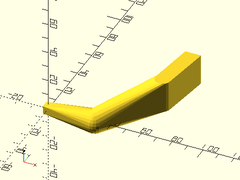
Usage:
- extrude_arc(arc, r|d, [sa], [caps], [orient], [align], [masksize]) ...
Description:
Extrudes 2D shapes around a partial circle arc, with optional rounded caps.
This is mostly useful for backwards compatability with older OpenSCAD versions
without the angle argument in rotate_extrude.
| Argument | What it does |
|---|---|
arc |
Number of degrees to traverse. |
sa |
Start angle in degrees. |
r |
Radius of arc. |
d |
Diameter of arc. |
orient |
The axis to align to. Use ORIENT_ constants from constants.scad
|
align |
The side of the origin the part should be aligned with. Use V_ constants from constants.scad
|
masksize |
size of mask used to clear unused part of circle arc. should be larger than height or width of 2D shapes to extrude. |
caps |
If true, spin the 2D shapes to make rounded caps the ends of the arc. |
convexity |
Max number of times a ray passes through the 2D shape's walls. |
Example:
pts=[[-5/2, -5], [-5/2, 0], [-5/2-3, 5], [5/2+3, 5], [5/2, 0], [5/2, -5]];
#polygon(points=pts);
extrude_arc(arc=270, sa=45, r=40, caps=true, convexity=4, $fa=2, $fs=2) {
polygon(points=pts);
}

Usage:
- round2d(r) ...
- round2d(or) ...
- round2d(ir) ...
- round2d(or, ir) ...
Description:
Rounds an arbitrary 2d objects. Giving r rounds all concave and
convex corners. Giving just ir rounds just concave corners.
Giving just or rounds convex corners. Giving both ir and or
can let you round to different radii for concave and convex corners.
The 2d object must not have any parts narrower than twice the or
radius. Such parts will disappear.
| Argument | What it does |
|---|---|
r |
Radius to round all concave and convex corners to. |
or |
Radius to round only outside (convex) corners to. Use instead of r. |
ir |
Radius to round/fillet only inside (concave) corners to. Use instead of r. |
Example 1:
round2d(r=10) {square([40,100], center=true); square([100,40], center=true);}

Example 2:
round2d(or=10) {square([40,100], center=true); square([100,40], center=true);}

Example 3:
round2d(ir=10) {square([40,100], center=true); square([100,40], center=true);}
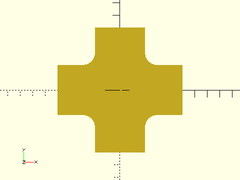
Example 4:
round2d(or=16,ir=8) {square([40,100], center=true); square([100,40], center=true);}

Usage:
- shell2d(thickness, [or], [ir], [fill], [round])
Description: Creates a hollow shell from 2d children, with optional rounding.
| Argument | What it does |
|---|---|
thickness |
Thickness of the shell. Positive to expand outward, negative to shrink inward, or a two-element list to do both. |
or |
Radius to round convex corners/pointy bits on the outside of the shell. |
ir |
Radius to round/fillet concave corners on the outside of the shell. |
round |
Radius to round convex corners/pointy bits on the inside of the shell. |
fill |
Radius to round/fillet concave corners on the inside of the shell. |
Example 1:
shell2d(10) {square([40,100], center=true); square([100,40], center=true);}
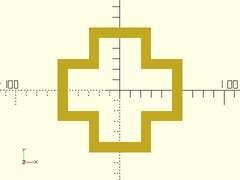
Example 2:
shell2d(-10) {square([40,100], center=true); square([100,40], center=true);}

Example 3:
shell2d([-10,10]) {square([40,100], center=true); square([100,40], center=true);}
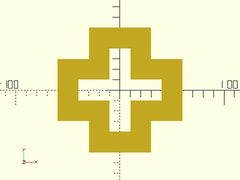
Example 4:
shell2d(10,or=10) {square([40,100], center=true); square([100,40], center=true);}

Example 5:
shell2d(10,ir=10) {square([40,100], center=true); square([100,40], center=true);}

Example 6:
shell2d(10,round=10) {square([40,100], center=true); square([100,40], center=true);}

Example 7:
shell2d(10,fill=10) {square([40,100], center=true); square([100,40], center=true);}

Example 8:
shell2d(8,or=16,ir=8,round=16,fill=8) {square([40,100], center=true); square([100,40], center=true);}
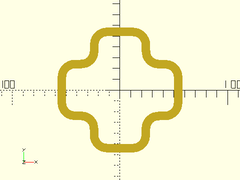
Usage:
- orient_and_align(size, [orient], [align], [center], [noncentered], [orig_orient], [orig_align], [alignments]) ...
Description:
Takes a vertically oriented shape, and re-orients and aligns it.
This is useful for making a custom shape available in various
orientations and alignments without extra translate()s and rotate()s.
Children should be vertically (Z-axis) oriented, and centered.
Non-extremity alignment points should be named via the alignments arg.
Named alignments, as well as ALIGN_NEG/ALIGN_POS are aligned pre-rotation.
| Argument | What it does |
|---|---|
size |
The size of the part. |
orient |
The axis to align to. Use ORIENT_ constants from constants.scad |
align |
The side of the origin the part should be aligned with. |
center |
If given, overrides align. If true, centers vertically. If false, align will be set to the value in noncentered. |
noncentered |
The value to set align to if center == false. Default: V_UP. |
orig_orient |
The original orientation of the part. Default: ORIENT_Z. |
orig_align |
The original alignment of the part. Default: V_CENTER. |
alignments |
A list of ["name", [X,Y,Z]] alignment-label/offset pairs. |
Example:
#cylinder(d=5, h=10);
orient_and_align([5,5,10], orient=ORIENT_Y, align=V_BACK, orig_align=V_UP) cylinder(d=5, h=10);
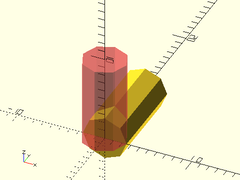
DEPRECATED, use place_copies() instead.
Usage:
- translate_copies(a) ...
Description: Makes copies of the given children at each of the given offsets.
| Argument | What it does |
|---|---|
a |
array of XYZ offset vectors. Default 0,0,0 |
Side Effects:
-
$posis set to the relative centerpoint of each child copy, and can be used to modify each child individually.
DEPRECATED, use spread(p1,p2) instead
Usage:
- line_of(p1, p2, [n]) ...
Description: Evenly distributes n duplicate children along an XYZ line.
| Argument | What it does |
|---|---|
p1 |
starting point of line. (Default: [0,0,0]) |
p2 |
ending point of line. (Default: [10,0,0]) |
n |
number of copies to distribute along the line. (Default: 2) |
Side Effects:
-
$posis set to the relative centerpoint of each child copy, and can be used to modify each child individually.
DEPRECATED, use grid3d() instead.
Usage:
- grid_of(n, spacing) ...
- grid_of(n=[Xn,Yn,Zn], spacing=[dX,dY,dZ]) ...
- grid_of([xa], [ya], [za]) ...
Description: Makes a 3D grid of duplicate children.
| Argument | What it does |
|---|---|
xa |
array or range of X-axis values to offset by. (Default: [0]) |
ya |
array or range of Y-axis values to offset by. (Default: [0]) |
za |
array or range of Z-axis values to offset by. (Default: [0]) |
n |
Optional number of copies to have per axis. |
spacing |
spacing of copies per axis. Use with n. |